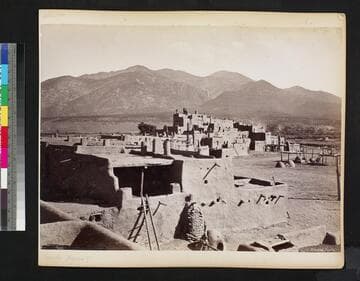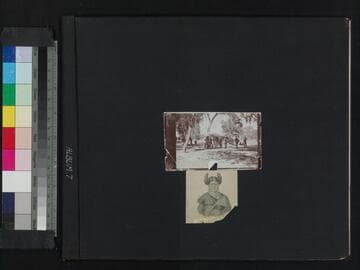Visual Materials
Photographs of Towns and Indians of the Southwest
You might also be interested in

Photograph album of Southwest Pueblos and portraits of Indian leaders, 1867-1890
Visual Materials
A disbound album of 74 photographs of Hopi pueblos of the Southwest, 1879-1880, and studio portraits of Indian leaders who visited Washington, D.C., on delegation trips, 1867-1890. The majority of individuals photographed are from the Ponca, Yankton Sioux, Navajo and Zuni tribes, with a smaller number of portraits of Apache, Sac & Fox, Ojibwa, and Two Kettle Sioux Indians. The first part of the album contains 26 views of pueblos in New Mexico and Arizona made by photographer John K. Hillers during surveys with the Bureau of Ethnology, Smithsonian Institution, 1879-1880. Almost all are broad scenes of the pueblos and surroundings, with one view of Hopi women in a dance circle at Oraibi and one view of a Navajo hogan. The second section of the album contains 48 studio portraits, including many Ponca Indian leaders listed in William Henry Jackson's "Descriptive Catalogue of Photographs of North American Indians" (1877). Other portraits include Yankton Sioux leaders (1867); Navajo chief Manuelito and his wife and son; We-Wha, a Zuni male transvestite; Zuni governor Pedro Pino; and other notable individuals. Besides Jackson, the portraits were made by photographers Charles M. Bell, Alexander Gardner, John K. Hillers and A. Zeno Shindler.
photCL 190

Horatio N. Rust Photograph Collection: Album of Indians of Southern California and the Southwest, approximately 1886-approximately 1905
Visual Materials
A photograph album compiled by Horatio Nelson Rust (1828-1906), U.S. Indian agent and archaeological artifact collector, documenting Indians living in Southern California, Arizona and New Mexico, approximately 1886-1905. Includes group portraits of Indian school students in California; members of the Cahuilla, Luiseno, Morongo, Mojave, Hopi, and Navajo tribes; the Indian Council at Pala, 1886; and scenes in Pechanga, Soboba and other native communities of Southern California. A smaller portion of the album includes Southwest and pueblo scenes; archaeological artifacts; and a few commercial photographs of North American Indians from elsewhere.
photCL 7
Image not available
Elizabeth Compton Hegemann Photograph Collection of Navajo Indians and the Southwest
Visual Materials
This collection contains 729 photographs of Elizabeth Compton Hegemann's travels through the Navajo Indian Reservation and the Grand Canyon from 1922 to 1934. It also documents Southwest Indian life and archaeological monuments during Hegemann's career based at the Shonto Trading Post on the Navajo Reservation in Arizona. The most notable images depict Hegemann; United States National Park Service rangers; Fred Harvey Trading Company sites and employees; Navajo and Hopi Indians; trading posts; Charles F. Lummis; the Grand Canyon; various ruins of Indian pueblos; Hopi ceremonies; Navajo horse races; and natural rock formations scattered throughout Arizona. Many of the photographs were published in Hegemann's 1963 book Navaho Trading Days. The subject of the first batch of this collection centers around Hegemann's experiences from 1922 to 1926 at the Grand Canyon and on the Navajo Reservation, as narrated in her book, Navaho Trading Days. The second batch of photographs contains more candid moments from Hegemann's travels through Arizona, Southern California, and New Mexico during the same time period as the first group of photographs. The second batch of photographs do not appear in "Navaho Trading Days." Photographs that are not published in "Navaho Trading Days" include Huntington call numbers (40-47), (84-85), (95), (119-142), (167), (170), (172-185), (257-271), (293-313), (340-361), (382-402), and (416-426).
photCL 125
Image not available
Sigurd Russell Photograph Collection of Southwest Indians and Schools
Visual Materials
A collection of photographs and postcards focusing on Navajo and Hopi Indians and various Indian schools and schoolchildren throughout Arizona, mostly dating from the 1920s, and compiled by Los Angeles teacher and journalist Sigurd Russell. There are views of Peach Springs Trading Post, the Cameron Suspension Bridge trading post, missions at Chinle and Lukachukai (Arizona), Navajo family groups, Navajo schools at Tuba City and Oraibi (Arizona), and Navajo school crafts fairs and exhibits. Acoma, Apache, Tohono O'odham (Papago), and Hualapai Indians are also represented. The photographs were taken from 1890 to 1927, but the bulk of the collection was created during the 1920s. Includes some photographs by George Wharton James, E.E. Hall, and Burton Frasher (Frasher Fotos) . These images of Indians were taken as both posed and candid field photographs, in particular of young Navajo schoolchildren during class time and outside of school. Other subjects pictured are L.H. McSparron, owner of Thunderbird Ranch and acting custodian of Canyon de Chelly; Father Leopold Ostermann, the founder of the mission at Chinle; possibly John Lorenzo Hubbell Jr., of the Hubbell trading family; an Indian all-boys track-and-field team at an unidentified school; Indian schoolchildren; and nature views throughout Arizona. Russell also collected postcards with images of Southwest Indians, with some cards having correspondence from Russell, addressed to Beatrice Madelleine, Mrs. George R. Simmons, and Madeleine Touchaux (Russell's wife), describing how travel conditions were as well as opinions on the Indians that were encountered.
photCL 399
Image not available
Album of Indians of Southern California and the Southwest
Visual Materials
A photograph album compiled by Horatio Nelson Rust (1828-1906), U.S. Indian agent and archaeological artifact collector, documenting Indians living in Southern California, Arizona and New Mexico, approximately 1886-1905. Includes group portraits of Indian school students in California; members of the Cahuilla, Luiseno, Morongo, Mojave, Hopi, and Navajo tribes; the Indian Council at Pala, 1886; and scenes in Pechanga, Soboba and other native communities of Southern California. A smaller portion of the album includes Southwest and pueblo scenes; archaeological artifacts; and a few commercial photographs of North American Indians from elsewhere. Some notable images include: a snapshot of Chief Joseph and his nephew standing in front of a train, 1898; views of Navajo Indians whom Rust brought to Pasadena, San Pedro and the Pacific Ocean, 1902-03; and Indian agent Tom Jeffords. Rust appears in several photographs throughout the album. The photographs were made by various photographers, mostly unidentified, but some are credited: C. J. Crandall; E. A. Bonine; C. S. Fly (reproductions of photographs of Geronimo); and John Grabill. The album is accompanied by a four-page index by Rust and a few pieces of ephemera, including a printed card of "The Lord's Prayer translated by William E. Connelley into the Wyandot language."
photCL 7
Image not available
Photographs and Lantern Slides of Artifacts and Indians of California, Southwest and Great Plains
Visual Materials
A collection of photographs and lantern slides compiled by Horatio Nelson Rust (1828-1906), a U.S. Indian agent and artifact collector in California in the late 19th century. The disbound photograph album in Boxes 1 and 2 include many views of Indian artifacts, such as arrowheads, pottery, metal and stone relics, some of which were excavated by Rust himself, as he describes in captions. There are also views of skulls excavated in Missouri, 1879, by Rust. Rust's handwritten captions identifying items and where they were found, by himself or others, are of particular interest in this collection. The album also contains photographs of Indians from Great Plains and western tribes, and Indian schools in Tahlequah, Oklahoma, and Perris, California. There are two striking "before and after" photographs of Chiricahua Apache children sent to Carlisle Indian School, Pennsylvania. Also of note are many views of Southern California Indians, including portraits of Cabazon, Soboba, Luiseno and Cahuilla tribe members, some partially identified by family names: Estudillo; Victoriano of Soboba; Lugo (or Lubo); Casero; Costo; Pablo "Chief of Cahuilla"; Silvestre. Other subjects included: two group portraits of Yuma Indian men, 1891; studio portraits of Keokuk (Sauk); Billy Bowlegs (Seminole); Ouray and Ignacio (Ute); reproductions of drawings of Indians on horses; reproductions of 17th-century deeds related to John Pynchon and colonial Deerfield, Massachusetts; a John K. Hillers photograph of John W. Powell, George W. Ingalls and others in Colorado, 1873; scenes of the Indian Council at Pala, California, 1886; Old Creek Indian Council House, Okmulgee, OK; and portraits of Sam Temple and the Cahuilla woman known as "Ramona," who inspired characters in Helen Hunt Jackson's novel, Ramona. Photographs in Box 3 include views of: Trinity River and vicinity, Northern California, approximately 1880s; camping; scenery; Indian workers standing outside agency; trading post; railroad station in Holbrook, Arizona; missions in California and Tucson, Arizona; Southwest Indians; portrait of Otis T. Mason; archaeological specimens; H. N. Rust family members. Most of the lantern slides in Boxes 4-7 are copies of photographs elsewhere in the Rust Collection, such as: Southwest Pueblo views by John K. Hillers (photCL 10); Rust's trip to Arizona, 1895, with A. C. Vroman (photCL 8). Topics of other slides: Southwest Indians by photographer Frederick H. Maude; San Gabriel Mission; two views of H. N. Rust's home; Aztec artifacts and ruins.
photCL 11